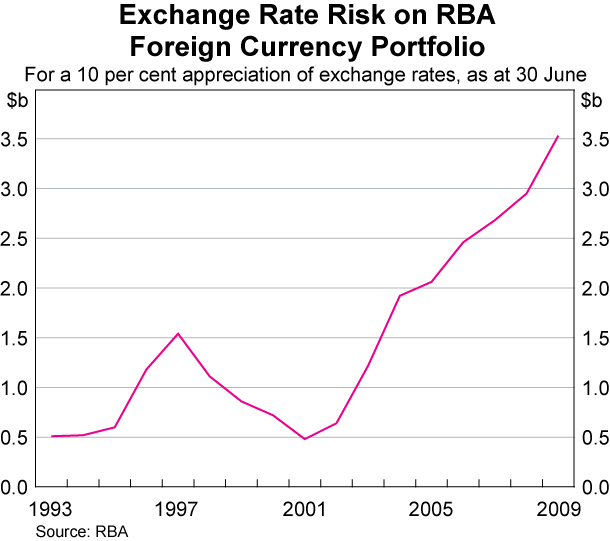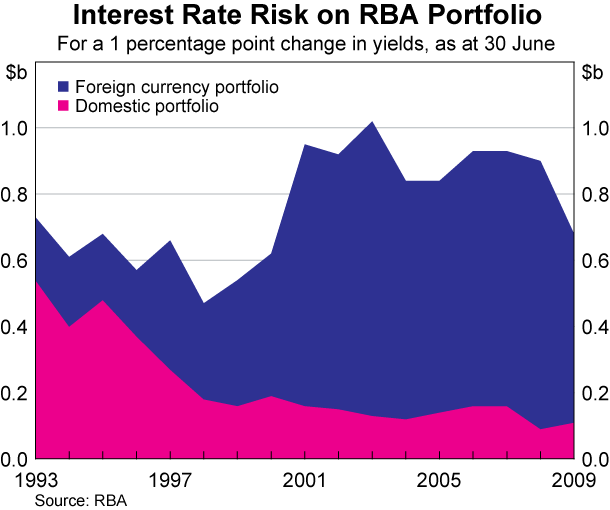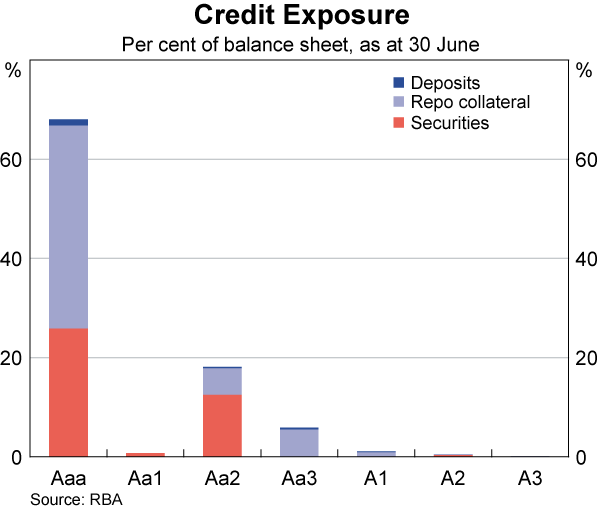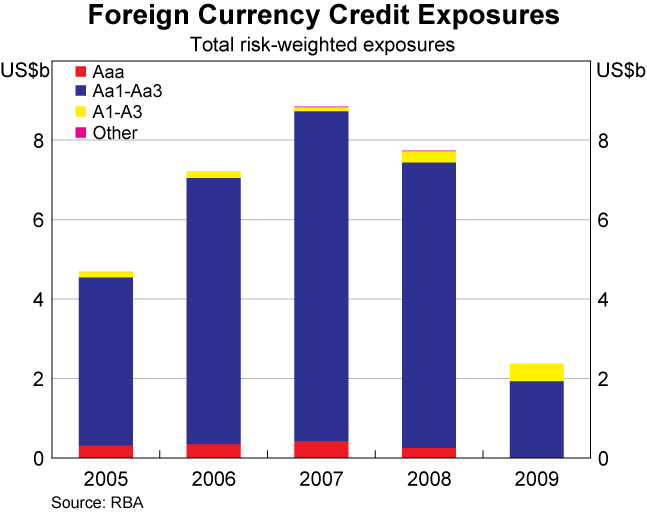Reserve Bank of Australia Annual Report – 2009 Risk Management
Objectives and Governance Structure
The Reserve Bank manages a range of financial and operational risks in carrying out its responsibilities as a central bank. The principal objective is not to eliminate risk – which is not always possible or comes at excessive cost – but rather to contain risk to a level that is consistent with the Bank effectively achieving its policy and operating objectives.
The Reserve Bank's risk management framework involves identifying and assessing risks as well as implementing and reviewing the effectiveness of controls. This framework is applied to all non-policy risks irrespective of whether they arise through one of the Bank's existing activities or through a new activity implemented to achieve a specific policy objective. Underpinning the framework is the principle that risk management is an integral part of each line manager's job. As such, the prime responsibility for controlling and mitigating risks on a day-to-day basis rests with managers of the various business areas within the organisation. More generally, management also promotes an active risk management culture that emphasises the careful analysis and control of risk as a vital and integral part of all business processes within the Bank.
Oversight of the Reserve Bank's arrangements for risk management rests with the Risk Management Committee. This is a senior committee responsible for ensuring that all of the non-policy risks facing the organisation are properly assessed and managed. It is chaired by the Deputy Governor and comprises the Assistant Governors for Banking and Payments, Corporate Services, Currency and Financial Markets; the Chief Financial Officer; the Heads of Audit and Risk Management; and the General Counsel and Deputy Secretary. It meets every three months, or more often if needed, and keeps the Bank's Executive Committee and the Board's Audit Committee advised of its activities. The Risk Management Committee is assisted in carrying out its responsibilities by the Risk Management Unit (RMU), whose main role is to help business areas of the Bank manage their risk environment within a broadly consistent framework across the organisation. Among the Unit's principal activities is monitoring risk and compliance with trading limits on the foreign and domestic asset portfolios.
Arrangements for managing risk are also supported by the Audit Department, which complements – but remains separate from – the work of the RMU. In addition to providing assurance that the Reserve Bank's risk management policy is effective, the Audit Department has a separate, independent brief to test the adequacy of procedures and controls at all levels of the Bank. The Audit Department has a direct reporting line to the Board's Audit Committee.
Similar to many other central banks, the Reserve Bank made a number of changes to its operations over the past year in response to global credit and financial market developments. Most of these involved adjustments to the Bank's operations in domestic financial markets and resulted in changes to the composition of the Bank's balance sheet. The Bank also took on new tasks – in particular, administration of the Government's Guarantee Scheme for Large Deposits and Wholesale Funding, which was put in place to assist financial institutions in maintaining access to funding markets. These changes typically involve some risks, which reflect the nature of the instruments used, the size of the transactions undertaken or simply because the tasks are new and involve unfamiliar systems and processes. The risks were assessed in a manner consistent with the Bank's risk management framework and, where appropriate, controls were put in place to ensure that they are managed to a level that is acceptable to the Bank in carrying out its responsibilities.
The sections below describe the various risks and associated management practices in more detail.
Portfolio Risks
The most significant risks the Reserve Bank faces in terms of potential financial impact flow directly from its operations in financial markets and the assets it holds to support these operations. The main risks are exchange rate risk, interest rate risk and credit risk. These are managed by the Financial Markets Group within a set of conservative parameters. The strict control framework has kept the Bank's exposure to generally low levels during the turbulent conditions that have characterised financial markets over the past 18 months.
As noted above, the RMU is responsible for monitoring risks and day-to-day compliance with the control framework. Compliance reports, together with reports on portfolio performance and risk, are provided daily to the Assistant Governor (Financial Markets), the Head of Risk Management and other senior staff.
Exchange Rate Risk
The Reserve Bank maintains a portfolio of foreign currency assets as holder of Australia's official reserves. The value of these assets changes with movements in the Australian dollar and can vary quite markedly during periods of substantial volatility in the exchange rate. The sharp depreciation of the Australian dollar between the end of July and late October 2008, for example, resulted in the value of the Bank's foreign currency assets rising by around 40 per cent in Australian dollar terms, while the appreciation since the beginning of 2009 reduced the magnitude of the rise to around 20 per cent.
The level of exchange rate risk on the portfolio is also determined by the size of the foreign portfolio, in foreign currency terms. This has been the principal cause of an increase in the Reserve Bank's exchange rate risk over the past 10 years. There was, however, little net change in the size of the Bank's foreign currency assets over 2008/09.
To control some of its exchange rate risk, the Reserve Bank spreads its holdings of foreign currency assets across a small number of highly liquid currencies – 45 per cent is held in US dollars, 45 per cent in euros and 10 per cent in yen. In the normal course of events, the portfolio is rebalanced to these shares each day. This involves buying and selling small quantities of foreign currency, usually in response to changes in market rates or transactions that the Bank undertakes for other purposes.
While the Reserve Bank typically maintains the 45-45-10 allocation fairly closely, rebalancing the foreign currency portfolio each day may not be practical in certain market conditions. For this reason, the Bank has on occasion chosen not to rebalance the portfolio, allowing the currency allocation to vary over a wider range than is usually tolerated. Consistent with this, the daily rebalancing of the currency allocation was suspended when the Bank intervened to provide liquidity to the Australian dollar market last year, but was re-activated over the first half of 2009 as market conditions improved, (see the chapter on ‘Operations in Financial Markets’ for more details).

Overall, the exchange rate risk on the portfolio rose over the year owing to the increase in the value of the portfolio in Australian dollar terms. As discussed above, there was little net change in risk from movement in the size of the portfolio, in US dollar terms. At the current level of reserves, the potential valuation loss from a 10 per cent appreciation of the Australian dollar (on a weighted average basis against the three currencies in the portfolio) would result in valuation losses of around $3.5 billion.
Interest Rate Risk
The Reserve Bank's financial assets are mainly domestic and foreign fixed-income securities. The value of these assets is subject to movements in domestic and foreign market yields. Since the income stream from these securities is fixed, a rise in market yields results in a fall in their value. Securities that have a longer maturity (or duration) contain a greater degree of interest rate risk, as cashflows further in the future are more sensitive to discounting than those in the near term.
The majority of the Reserve Bank's financial assets are invested in highly rated domestic securities, which are held for policy-related purposes. Action taken by the Bank to deal with turbulence in local financial markets resulted in a significant increase in holdings of domestic securities during the first half of 2008/09 (see the chapter on ‘Operations in Financial Markets’ for more details). This was unwound over the second half of the year, however, as market conditions improved. At the end of June 2009, total holdings of domestic securities were $47 billion, around $8 billion lower than a year earlier.
While the increase in size of the domestic portfolio affects the level of interest rate risk facing the Reserve Bank, the overall level of risk in the portfolio is fairly small. This is because a significant portion of the Bank's domestic securities is held under repurchase agreements (repos) with short terms to maturity. Over the course of the financial year, the average term to maturity of the Bank's domestic repos rose. The move was largely concentrated in the first half of the year as the Bank responded in its market operations to an increase in demand for longer-term funding from banks and other financial institutions. Even so, the increase in the term to maturity was not large in absolute terms. At its peak, the average term to maturity of the Bank's holdings of repos was around 150 days, compared with around 65 days at the start of the financial year. Demand for longer-term funding eased somewhat in the second half of the year as the market settled. The average term to maturity had declined to around 90 days by the end of June 2009.
Outright holdings of securities represent only a small proportion of the domestic portfolio. Purchases of short-dated securities, which are typically undertaken as part of the Reserve Bank's daily market operations, increased over the year. However, as for repos, the interest rate risk on these securities is very low and, as a result, these purchases had little effect on the overall level of price risk. Interest rate risk on outright holdings of long-dated securities is, by comparison, much higher. The Bank's holdings of these securities are, however, historically low and their overall contribution to risk within the Bank's domestic portfolio is correspondingly low.
Because of the unique nature of its liabilities, the Reserve Bank has little exposure to interest rate movements on its balance sheet obligations. The principal liability is notes on issue, which carry no interest cost to the Bank. The most significant of the other liabilities are deposits held by the Australian Government and government agencies and settlement balances held by authorised deposit-taking institutions (ADIs). These deposits have short maturities that broadly match those of the domestic assets, particularly those held as repos. Interest paid on these deposits reflects domestic short-term rates, which, in turn, offsets the interest rate exposure of domestic assets. In September 2008, the Bank introduced a term deposit facility for ADIs, designed to assist institutions in managing settlement balances at the height of the market turmoil. These deposits were offered through to March this year. A rate slightly below the cash rate was paid on them.
In contrast to the domestic asset portfolio, the interest rate risk on the foreign portfolio is managed relative to a benchmark that is specified in terms of portfolio duration. The different approaches for the two portfolios reflect different portfolio objectives. While the domestic portfolio is held solely for domestic policy purposes, the Reserve Bank's foreign currency assets are held to provide capacity for intervention in the foreign exchange market. As these operations are typically infrequent, the Bank has scope to invest in foreign assets that earn a market-based return, subject to high degrees of security and liquidity.
For some time, the benchmark for the foreign portfolio has been set at 30 months for each of the three currency portfolios (US dollars, euros and yen). This duration has generally been consistent with the Reserve Bank's long-term risk and return preferences, given the objectives of the foreign currency portfolio. However, in response to developments in asset markets over the past year, which saw interest rates and bond yields reach historically low levels over the first half of 2009, the Bank decided in April to reduce the benchmark duration for all three foreign portfolios to 18 months, thereby reducing the overall level of interest rate risk in the portfolio. This is the first change in benchmark duration since the mid 1990s. The move to the lower duration target was effected gradually to avoid disrupting relevant markets.
Looking at the domestic and foreign assets together, the interest rate risk on the Reserve Bank's assets declined over the year; the Bank would record a valuation loss of about $700 million if interest rates in Australia and abroad rose uniformly by 1 percentage point across the yield curve, compared with $900 million last year.

Credit Risk
Credit risk is the potential for financial loss arising from the default of a debtor or issuer. The Reserve Bank manages its credit exposure to a low level by applying a set of strict criteria to potential investments. These primarily involve dealing with highly rated counterparties and in highly rated assets. During the year two factors affected the Bank's approach to managing credit risk: the rating downgrades to a number of the Bank's counterparties and the Bank's actions to deal with financial market developments, which resulted in some changes to the composition of its assets. The Bank's credit risk framework accommodated these developments so that its exposure to credit risk remained low.

The Reserve Bank holds only highly rated securities to minimise exposure to credit risk. For the domestic portfolio, the securities held outright include those issued by the Australian Government or by State and Territory government borrowing authorities. As discussed above, a large portion of the domestic portfolio consists of securities held under repo. Although credit risk inherent to repos is generally limited, there is a residual credit exposure related to the quality of collateral and its market value when the repo matures – the Bank would face a potential loss if a counterparty failed to repurchase securities sold under repo and the market value of the securities was less than the value of the initial cash consideration. The Bank manages this by applying an appropriate margin (or ‘haircut’) to the collateral and maintaining a high credit standard for securities it is prepared to accept under repo.
The Reserve Bank requires that the initial cash position of repos be over-collateralised. It also requires that the collateral be revalued each day and that counterparties supply additional securities once the market value of the collateral falls below a required amount. The degree of over-collateralisation is generally set at 2 per cent for government-backed securities and securities regarded as ‘general collateral’, but as high as 10 per cent for some long-dated privately issued securities. The degree of collateralisation is monitored daily by the RMU and advice is given to the Bank's front-office dealers when a margin call is required to maintain the degree of over-cover.
The degree of over-cover required by the Reserve Bank was higher for transactions under the US dollar term repo facility, which was set up in late 2008 to ease pressure in offshore markets for US dollars. (This facility is discussed in detail in the chapter on ‘Operations in Financial Markets’.) Counterparties to these transactions are required to post the usual margin for Australian dollar-denominated collateral, plus an additional 10 percentage points. The additional margin is to cover a greater level of default risk arising from the fact that, while the collateral is denominated in Australian dollars, the cash leg of the transaction is in a different currency. No operations in US dollar term repos have been conducted since May, reflecting improved conditions in the market for US dollars.
Over the past 10 years or so, the Reserve Bank has gradually expanded the range of highly rated securities that it will accept as collateral beyond government securities, which are the securities traditionally used by central banks in market operations. In general, the expansion has been prompted by the evolving nature of Australian debt markets and, more recently, by the need to ensure that markets did not become dysfunctional during the turmoil in financial markets. During 2008/09, the range was expanded further to include government-guaranteed securities issued by ADIs, corporate bonds, asset-backed securities and commercial paper. Consistent with the Bank's strict credit requirements for collateral, these securities are accepted by the Bank only if they have a long-term rating of Aaa or a short-term rating of P-1.
While the Reserve Bank does not generally accept as collateral securities that counterparties have issued themselves or by a party to which they are related, this restriction was relaxed during the year for offers of residential mortgage-backed securities (RMBS) and asset-backed commercial paper (ABCP). The overall impact on credit risk resulting from this change was small, as the security would continue to be collateralised by the underlying assets in the event of a default by the counterparty. Furthermore, under the Bank's requirements for this type of collateral, the majority of the underlying mortgages are insurable, ‘full-doc’ loans. The condition of the asset pool underlying the securities is also monitored by the RMU.
The impact of these changes over the past year altered the composition of the securities that the Reserve Bank holds under repo. Holdings of RMBS now comprise around 60 per cent of the total collateral pool. They have largely replaced bank bills and certificates of deposit as the largest asset class in the portfolio. Though the overall credit quality of the Bank's portfolio was already very high, the generally higher credit rating of RMBS increased this credit quality.
The Reserve Bank's counterparties for domestic operations include banks and non-bank financial institutions. The Bank does not explicitly assign a minimum credit rating to counterparties, as the operations are conducted for policy purposes. Instead, the risk is managed by dealing only with members of the Reserve Bank Information and Transfer System (RITS). Maintaining a high credit quality for collateral and imposing a suitable haircut on transactions are other measures used to manage counterparty credit risk on domestic operations.
Similar to its domestic portfolio, the Reserve Bank confines most of its holdings of foreign assets to highly rated securities. Outright holdings are concentrated in liquid fixed-income assets issued by the national governments of the United States, Germany, France, Netherlands and Japan. The foreign asset portfolio also maintains a modest holding of securities issued by certain Aaa-rated supranational institutions. Following action in a number of countries to underpin key financial institutions during the market turmoil, the range of securities that the Bank can hold outright was expanded during the year to include select government-guaranteed securities and securities issued by US agencies, providing greater scope for holding high-quality assets in the portfolio. Purchases of government-guaranteed securities are subject to a set of strict criteria, including clear evidence that the guarantee is unconditional and irrevocable, and that both the guarantor and the issuer have a high credit rating.
For operational reasons, the Reserve Bank also holds a small portion of the foreign portfolio in cash, which is invested in commercial bank deposits and repos. These assets expose the bank to credit risk because of the possibility of counterparty default. The risk is managed through a combination of measures that, in effect, limit the level of exposure to a counterparty based on their capital base and long-term credit rating and on the type of investment undertaken. The minimum counterparty rating for bank deposits is Aa3, while for foreign exchange and repos the minimum rating is A3 and Baa1, respectively, reflecting the generally lower level of risk for these products. Overlaying this framework is a limit on the share of the foreign portfolio that can be held in commercial bank deposits. Over the course of the financial year, this limit was lowered from 20 per cent to 10 per cent. The reduction in holdings of bank deposits was largely effected by switching into repos as the deposits matured, minimising the overall liquidity impact on cash markets.

With most of the Reserve Bank's foreign assets held in highly rated securities, the reduction in the overall share of assets held in deposits contributed to a significant reduction in credit exposure on the Bank's foreign portfolio over the year. There was also little material change in the overall credit quality of the Bank's assets, which, reflecting the Bank's conservative risk framework, remained high. The majority are rated Aa3 or higher.
Operational Risks
The Reserve Bank faces operational risks that can arise from inadequate or failed internal processes and systems or from external events. These risks are similar to those faced by other financial institutions. They range from the possibility that access to key financial infrastructure might be lost, to the possibility that services might not be delivered to the required standard because processes have not been followed. The Bank also faces security risks, both IT and physical, because its IT systems are critical to its operations, and because of the value of the physical assets it holds.
A significant risk facing any financial institution is that its staff may engage in fraud or undertake unauthorised transactions, exposing the institution to significant financial loss or reputational damage. The Reserve Bank has a number of measures in place to manage this risk. These include having a clear decision-making hierarchy, with the staff involved in all financial dealing having limits to their authority to take risks or pass value, and controls over computer access at both the user and administrator levels. These arrangements are further enhanced by independent front, middle and back office functions, where staff who initiate trades, those who settle them, and those who monitor and report on exposures and compliance with trading and investment guidelines are physically separate and have separate reporting lines within the organisation. Separation of duties is strictly enforced.
The Reserve Bank's Code of Conduct for employees sets out the standard of integrity and propriety that is expected of staff in carrying out their duties. This is supported by the Bank's Fraud Control Policy and related arrangements, which enable staff to report suspicious behaviour anonymously. Staff are periodically reminded of these arrangements and the Fraud Control Policy is reviewed regularly to ensure that it remains up to date.
Operational risks arise in the Financial Markets Group from the large number of transactions undertaken each day and because dealing arrangements are altered from time to time. Around 70,000 transactions were undertaken in 2008/09, generating average daily settlement flows of around $40 billion. These figures are lower than the corresponding figures for the previous financial year, with much of the decrease reflecting a general lengthening of the maturity of transactions undertaken in domestic market operations during the year. The risks associated with this volume of transactions are managed by ensuring that systems and processes, including change management processes, are efficient and robust. Consistent with this, the Reserve Bank completed an upgrade of its financial markets trading system and supporting computer hardware over 2008/09. The upgrade was carried out under standard guidelines for project management, with rigorous testing of software, hardware and links to management systems occurring before the upgraded system went into production in April.
Continuity of services to clients and market participants, and high availability of systems, are key considerations because interruptions could have potentially widespread or systemic consequences. The Reserve Bank is the main banker for a number of government agencies, including the Australian Taxation Office, Medicare Australia and Centrelink. On average, the Bank processes around 285 million transactions each year on behalf of these customers, though the number was around 9 million higher in 2008/09 partly because of the extra processing of payments made under the Australian Government's stimulus packages. The Bank also provides real-time interbank payment and settlement services through RITS, which typically involves processing about 32,000 payment instructions per day, for an average total value of $184 billion. To ensure that RITS can continue to handle significant volumes in an efficient manner, the Bank commenced a program in 2003 to modernise the system's technical architecture and functionality. The latest stage of this work, which involved upgrading core system hardware, the operating system and database, was completed in February.
The Reserve Bank has back-up capacity to ensure that its critical operations can be maintained if access to facilities or IT systems at its Head Office is lost. Some 60 staff are based permanently at the Bank's business recovery site to ensure that the key payments, markets and banking services can be restored quickly if the Head Office is unexpectedly disrupted. In the event of a prolonged outage, this site has capacity for nearly 230 staff. Business areas within the Bank regularly test their back-up arrangements at the site – some 30 tests were undertaken over the course of 2008/09. In addition, a large-scale test, involving staff from most of the Bank's departments, as well as external service providers, is conducted at the site twice a year.

In response to concerns about the possibility of a pandemic of H1N1, the Reserve Bank reviewed its arrangements for managing a widespread outbreak of influenza. Such an event raises quite different business continuity challenges, since the risk is that staff, rather than facilities and/or systems, become unavailable.
Notwithstanding strong controls, and a culture in which staff manage risk carefully, operational or other failures occur from time to time, which can have an adverse financial or reputational impact on the Reserve Bank. Such incidents are reported in a timely way to the Risk Management Committee, which monitors the reports to identify areas where the control framework can be strengthened.
Government Guarantee Scheme
As mentioned above, one of the new tasks taken on by the Reserve Bank over the past year has been administration of the Guarantee Scheme for Large Deposits and Wholesale Funding on behalf of the Australian Treasury. Under the scheme, which commenced operations in late November 2008, ADIs in Australia may seek a guarantee from the Government for deposit balances in excess of $1 million and certain wholesale funding liabilities. A fee based on the institution's credit rating is charged on the outstanding guaranteed liabilities.
The Reserve Bank's role in administering the scheme involves processing applications from ADIs, issuing guarantee certificates to successful applicants, processing and reporting monthly fee payments, monitoring guaranteed liabilities, and maintaining a website with relevant information about the scheme and the liabilities that have been guaranteed.
Administration of the scheme does not present any financial risk to the Reserve Bank – the liability to cover all claims under the scheme rests with the Australian Government. However, there would have been potential financial disruption and risk to the Bank's reputation if the scheme had been poorly administered. Accordingly, considerable resources were devoted to setting up and operating the administrative systems for the scheme. Around 550 certificates of guarantee have been issued since the scheme commenced in November, with ADIs paying almost $480 million in fees to the Australian Government. The cost of administering the scheme in 2008/09 came to about $250,000.
In late March, the Government announced a similar scheme to guarantee State and Territory borrowing. This scheme – which commenced operation in late July – is also administered by the Reserve Bank.